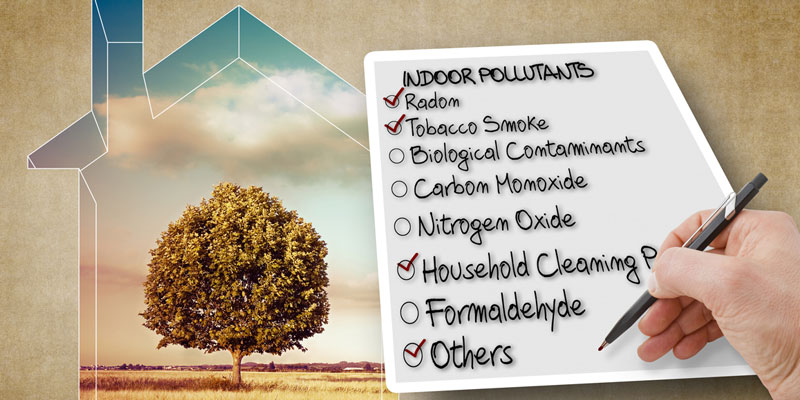Indoor Air Quality (IAQ) refers to the air quality within and around buildings and how it relates to the health and comfort of building occupants. Understanding and controlling common pollutants can help reduce your risk of certain health concerns. Air is essential to life. The average person breathes 2000 gallons of air each day.
Some health effects may show up shortly after a single exposure or repeated exposures to a pollutant, while others represent themselves after years of potential exposure.
Short term effects can include irritation of the eyes, nose, and throat, headaches, dizziness, and fatigue. Some of the most common long-term illnesses include pneumonia, stroke, ischaemic heart disease, chronic obstructive pulmonary disease (COPD), and lung cancer. According to the World Health Organization, close to 4 million people each year die prematurely from illnesses attributable to household air pollution stemming from inefficient cooking practices such as using polluting stoves, solids fuels, and kerosene. Individual pollutants such as carbon monoxide can lead directly to death. As of 2013 in Washington state, all homes must be equipped with carbon monoxide detectors to help alert of exposure to carbon monoxide.
Indoor air pollutants include:
- Asbestos
- Biological Pollutants
- Carbon Monoxide (CO)
- Formaldehyde/Pressed Wood Products
- Lead (Pb)
- Nitrogen Dioxide (NO2)
- Pesticides
- Radon (Rn)
- Indoor Particulate Matter
- Secondhand Smoke/ Environmental Tobacco Smoke
- Stoves and Heaters
- Fireplaces and Chimneys
- Volatile Organic Compounds (VOCs)
Pollutant sources include:
- Fuel-burning combustion appliances
- Tobacco products
- Building materials and furnishings:
- Deteriorated asbestos-containing insulation
- Newly installed flooring, upholstery or carpet
- Cabinetry or furniture made of certain pressed wood products
- Products for household cleaning and maintenance, personal care, or hobbies
- Central heating and cooling systems and humidification devices
- Excess moisture
- Outdoor sources such as:
- Radon
- Pesticides
- Outdoor Air Pollution
The most common pollutants in our region are biological (mold, dander, pollen), combustion (furnaces, fireplaces), formaldehyde (building materials), volatile organic compounds, semi-volatile organic compounds (flame-retardants), lead, indoor particulate matter (dust), and asbestos.
With the average American spending roughly 90% of their time indoors – where pollution levels can run two to five times higher than outdoors – the importance of IAQ is clear.
If a building has inadequate ventilation, indoor pollutants can accumulate to levels that pose health issues. Conversely, outdoor air can infiltrate buildings through openings, joints, cracks in walls, floors, and ceilings, and around doors and windows. When naturally ventilated, air moves through open windows and doors, however, when there is too little infiltration, natural ventilation, or mechanical ventilation, the air exchange rate is low and can lead to an increase in pollutant levels. Subsequently, the energy efficiency of the space is directly correlated to the IAQ.
Some of the most common issues in drafty homes with poor IAQ in our region include mold, window condensation, structural rot, peeling paint, back-drafting appliances, and high utility costs.
There are a number of things that can be done to improve your indoor air quality:
- Don’t smoke indoors.
- Install carbon monoxide detectors if your home is not already equipped with them.
- Use materials, finishes, and cleaning supplies that do not emit toxins.
- Ventilation – If you increase the amount of fresh air brought indoors it can reduce the pollutants inside. Bathroom and kitchen fans, as well as whole house fans are a great way to circulate air in the home.
- Change Furnace Filter Regularly – Filters in your furnace work to collect dust and other pollutants. If you change your filters monthly, your furnace will work at an optimal level, and ensure as many pollutants are being trapped as possible.
- Adjusting Humidity Levels – Monitoring your houses humidity levels decreases the likelihood of mold growth. Use your bathroom fans after showering and if you use a humidifier, make sure to regularly clean the unit and monitor the humidity level. Hardware stores have a humidity gauge and it is recommended to keep the humidity under 50%.
- Housekeeping – Routine house cleaning can drastically reduce the amount of air pollutants in your home. Additionally, using a HEPA filter on a vacuum can capture even the smallest of particles. Using a damp mop on floors and damp dusting helps keep airborne particles from being released into the air and settling elsewhere.
For More Information Regarding Indoor Air Quality here are some good websites:
- Global Indoor Health Network
- Healthy House Institute
- King County Public Health
- Home Ventilating Institute

